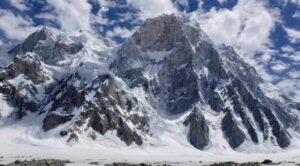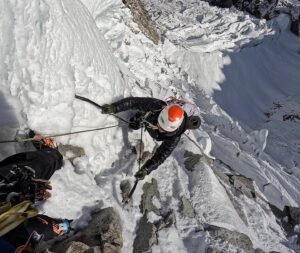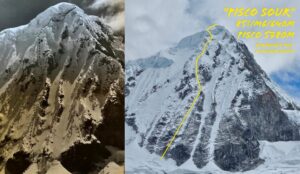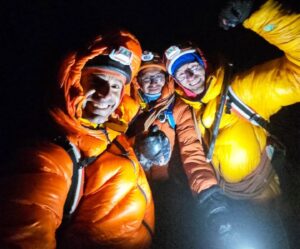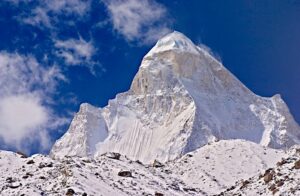At the end of August, Eneko Pou, Iker Pou, and Micher Quito did the first ascent of the northwest face of 6,162m Ranrapalca in the Peruvian Andes. The trio climbed this Cordillera Blanca peak free and in alpine style.
After opening several routes in the Karakoram, among them Waa Shakir 6b M5 70˚, 2,200m on Trango II (with Fay Manners), the Spanish brothers headed to the Andes.

On the northwest face of Ranrapalca. Photo: Pou brothers
They first saw Ranrapalca last year, when they and Quito opened Hanan Pacha and Emmoa on 5,495m Urus. On the other side of the valley, they spotted Ranrapalca and a possible route up it. At the time, however, they weren’t sure if they would be able to climb something so long, vertical, and complex at more than 6,000m.
“In fact, we tried it then but were already very worn out after a two-month expedition,” said Eneko Pou. “With the route in bad condition because of a lack of snow, we decided to turn around.”
This year, they decided to try again. It took them two days of climbing to open the first route on Ranrapalca’s northwest face to the top. They named the route Ya Pe’ Cholo 6b/80 degrees/1,200m.

Climbing on Ranrapalca. Photo: Pou brothers
Long, hard, and exposed
“It was a hard, exposed, and very long climb,” recalled Eneko Pou. “Climbing such a big wall with about 20kg on your back multiplies the difficulty. It was exposed because at the end of the season, and with the heat, rocks and ice were falling constantly around us.”
The Pou brothers say that they had a perfect synchronization with Quito. Eneko Pou led nine pitches on the first day, while Iker Pou and Quito carried much of the weight during the more than 13 hours of climbing.
Eventually, they reached a ledge more than 500m from the ground that seemed good for a bivouac. However, rocks fell around them constantly throughout the night. In the morning, it was difficult to climb some grade-six pitches with heavy backpacks and the temperature well below zero.
That second day, Iker Pou led the climb up to a plateau. From there, Quito took the lead. “We needed relief because we were both very worn out,” said Eneko Pou.
They had to jump over several large crevasses on the plateau before summiting that afternoon. Fifteen minutes after topping out, the trio started to descend.
“We knew we had to move quickly because we had several vertical rappels coming up and then we had to cross a glacier full of terrifying crevasses,” they recalled.

Micher Quito (left) and Iker Pou on the bivy ledge. Photo: Pou brothers
On the last rappel, they had a close call when a huge rock glanced off Eneko Pou’s head, briefly knocking him unconscious. But he eventually recovered and was able to continue the rappel. They finally reached the Giordano Longoni shelter in the middle of the night, after crossing a labyrinth of crevasses.
“Being able to imagine, devise, and create new avant-garde projects allows us to further the evolution of mountaineering and to try to leave a good legacy behind us,” said Eneko Pou.

From left to right, Eneko Pou, Micher Quito, and Iker Pou on top of Ranrapalca. Photo: Pou brothers


